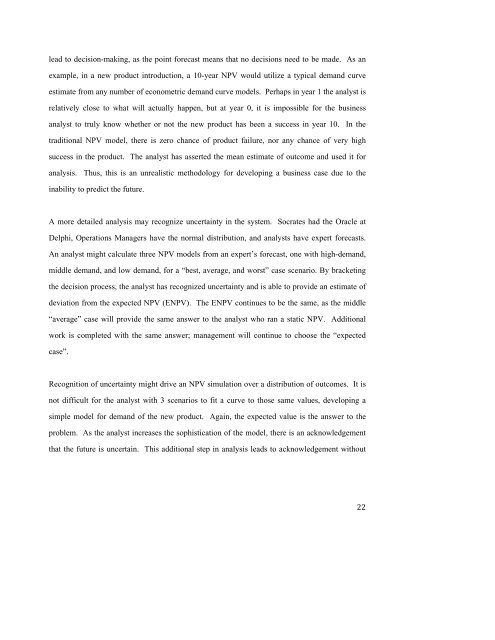A Case Study on Automotive Battery System Design - Title Page - MIT
A Case Study on Automotive Battery System Design - Title Page - MIT
A Case Study on Automotive Battery System Design - Title Page - MIT
- No tags were found...
Create successful ePaper yourself
Turn your PDF publications into a flip-book with our unique Google optimized e-Paper software.
lead to decisi<strong>on</strong>-making, as the point forecast means that no decisi<strong>on</strong>s need to be made. As anexample, in a new product introducti<strong>on</strong>, a 10-year NPV would utilize a typical demand curveestimate from any number of ec<strong>on</strong>ometric demand curve models. Perhaps in year 1 the analyst isrelatively close to what will actually happen, but at year 0, it is impossible for the businessanalyst to truly know whether or not the new product has been a success in year 10. In thetraditi<strong>on</strong>al NPV model, there is zero chance of product failure, nor any chance of very highsuccess in the product. The analyst has asserted the mean estimate of outcome and used it foranalysis. Thus, this is an unrealistic methodology for developing a business case due to theinability to predict the future.A more detailed analysis may recognize uncertainty in the system. Socrates had the Oracle atDelphi, Operati<strong>on</strong>s Managers have the normal distributi<strong>on</strong>, and analysts have expert forecasts.An analyst might calculate three NPV models from an expert’s forecast, <strong>on</strong>e with high-demand,middle demand, and low demand, for a “best, average, and worst” case scenario. By bracketingthe decisi<strong>on</strong> process, the analyst has recognized uncertainty and is able to provide an estimate ofdeviati<strong>on</strong> from the expected NPV (ENPV). The ENPV c<strong>on</strong>tinues to be the same, as the middle“average” case will provide the same answer to the analyst who ran a static NPV. Additi<strong>on</strong>alwork is completed with the same answer; management will c<strong>on</strong>tinue to choose the “expectedcase”.Recogniti<strong>on</strong> of uncertainty might drive an NPV simulati<strong>on</strong> over a distributi<strong>on</strong> of outcomes. It isnot difficult for the analyst with 3 scenarios to fit a curve to those same values, developing asimple model for demand of the new product. Again, the expected value is the answer to theproblem. As the analyst increases the sophisticati<strong>on</strong> of the model, there is an acknowledgementthat the future is uncertain. This additi<strong>on</strong>al step in analysis leads to acknowledgement without22
















